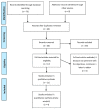Effects of Mirror Neurons-Based Rehabilitation Techniques in Hand Injuries: A Systematic Review and Meta-Analysis
- PMID: 35564920
- PMCID: PMC9104298
- DOI: 10.3390/ijerph19095526
Effects of Mirror Neurons-Based Rehabilitation Techniques in Hand Injuries: A Systematic Review and Meta-Analysis
Abstract
Background: Hand trauma requires specific rehabilitation protocol depending on the different structures involved. According to type of surgical intervention, and for monitoring pain and edema, post-operative rehabilitation of a hand that has experienced trauma involves different timings for immobilization. Several protocols have been used to reduce immobilization time, and various techniques and methods are adopted, depending on the structures involved. Objective: To measure the effects of mirror neurons-based rehabilitation techniques in hand injuries throughout a systematic review and meta-analysis. Methods: The protocol was accepted in PROSPERO database. A literature search was conducted in Cinahl, Scopus, Medline, PEDro, OTseeker. Two authors independently identified eligible studies, based on predefined inclusion criteria, and extracted the data. RCT quality was assessed using the JADAD scale. Results: Seventy-nine suitable studies were screened, and only eleven were included for qualitative synthesis, while four studies were selected for quantitative analysis. Four studies were case reports/series, and seven were RCTs. Nine investigate the effect of Mirror Therapy and two the effect of Motor Imagery. Quantitative analyses revealed Mirror Therapy as effective for hand function recovery (mean difference = −14.80 95% Confidence Interval (CI) = −17.22, −12.38) (p < 0.00001) in the short term, as well as in long follow-up groups (mean difference = −13.11 95% Confidence Interval (CI) = −17.53, −8.69) (p < 0.00001). Clinical, but not statistical, efficacy was found for manual dexterity (p = 0.15), while no benefit was reported for range of motion. Conclusions: Mirror neurons-based rehabilitation techniques, combined with conventional occupational and physical therapy, can be a useful approach in hand trauma. Mirror therapy seems to be effective for hand function recovery, but, for motor imagery and action observation, there is not sufficient evidence to recommend its use. Further research on the efficacy of the mirror neurons-based technique in hand injury is recommended.
Keywords: hand injuries; mirror neurons; mirror therapy; motor imagery; rehabilitation; systematic review.
Conflict of interest statement
The authors declare no conflict of interest.
Figures





References
-
- Crowe C.S., Massenburg B.B., Morrison S.D., Chang J., Friedrich J.B., Abady G.G., Alahdab F., Alipour V., Arabloo J., Asaad M., et al. Global Trends of Hand and Wrist Trauma: A Systematic Analysis of Fracture and Digit Amputation Using the Global Burden of Disease 2017 Study. Inj. Prev. 2020;26:i115. doi: 10.1136/injuryprev-2019-043495. - DOI - PMC - PubMed
-
- Thien T.B., Becker J.H., Theis J.-C. Cochrane Database of Systematic Reviews. John Wiley & Sons, Ltd.; Hoboken, NJ, USA: 2004. Rehabilitation after Surgery for Flexor Tendon Injuries in the Hand. - PubMed
Publication types
MeSH terms
LinkOut - more resources
Full Text Sources
Medical

